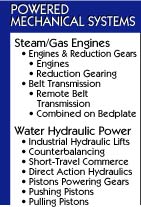
|
Water
Hydraulic Power
Water! The lifting of water was
the first preoccupation of early humans as they entered the era of systematic
agriculture. In turn, water later became the primary medium of lifting for
two centuries. It was a tremendous servant when converted to steam at the
outset of the European Industrial Revolution -- one of the igniting sparks!
For a brief period, it was used as a counterbalance; then, backed by central
or on-site steam or gas engines, it was the medium that pushed and pulled
-- either through roping or direct-action -- lifting very heavy loads and
moving passengers to new heights at previously unobtainable speeds. Water
was easily manipulated by primitive, then increasingly sophisticated valve
systems. In this era, the sinking of holes for cylinders became a new art
form, and the elevator industry learned to use accumulators and counterweights
with increasing expertise. The need for piston and valve packing engendered
new materials and techniques. New alloys and finer finishes were developed
for cylinders, pistons and valve blocks to take higher pressures and provide
smoother operation. The water hydraulic era began with slow, heavy industrial
lifting at the docks, foundries and factories; migrated to low-level commercial
lifting, then moved on to high-speed passenger applications with either
direct action or the multiplication of sheaving. On the way, the enormous
lifting capacities of water hydraulics was tapped to lift, often with equalization,
rail equipment, stage lifts and other enormous loads once thought unmanageable.
So efficient were the hydraulic elevators they were to reappear during the
electric era, in a new dimension and renewal of their former glory, powered
by oil instead of water! |

|


